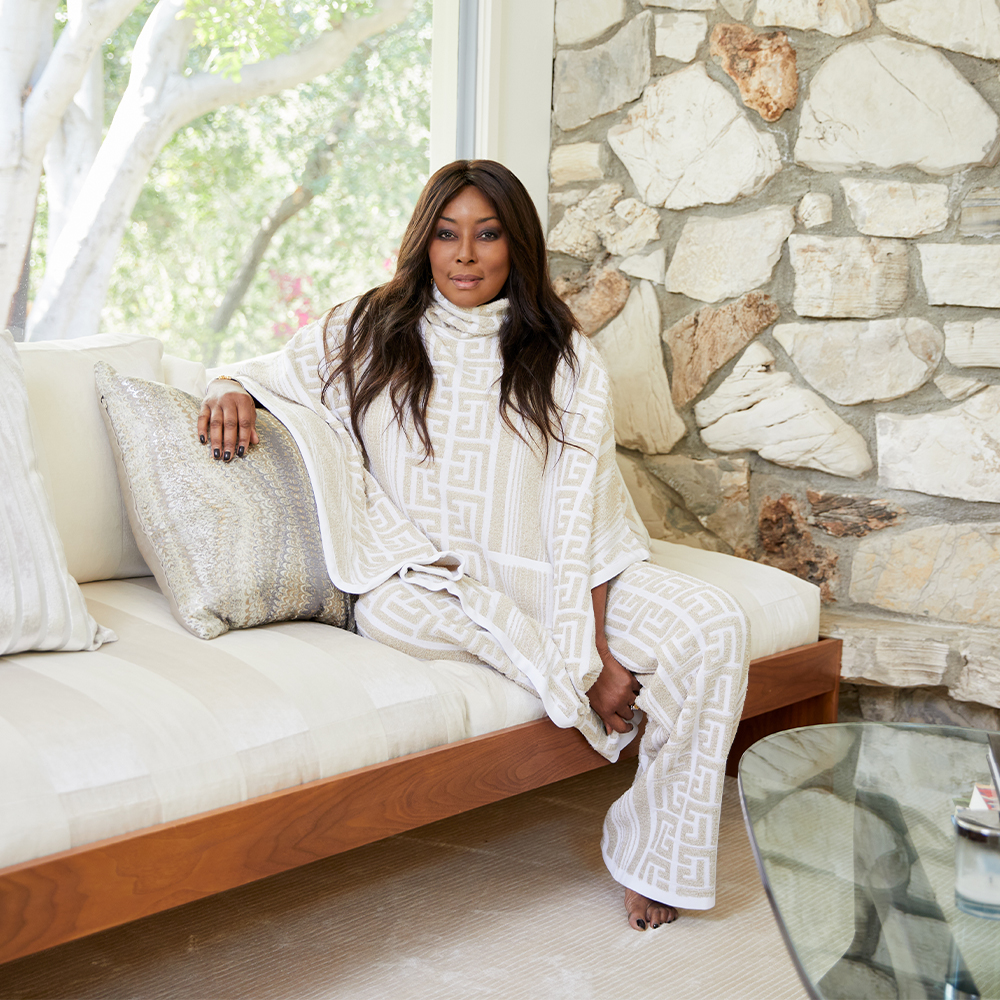
January 5, 2015Author Lesley Frowick and her uncle Halston celebrate their shared birthday, April 23, in 1988. Top: The famed fashion designer in his Paul Rudolph-designed New York home, a frequent party spot for the Studio 54 crowd in the 1970s. All photos courtesy of Rizzoli
May this year be one of blessed ideas for you, blessed ideas that come from wondrous dreams.” Several decades after the legendary choreographer Martha Graham sent these good wishes to Halston, Rizzoli has released what could be called the first definitive monograph on the late fashion designer and his legacy. Reproduced alongside a portrait of the two holding hands, Graham’s note is one of many never-before-seen personal letters, snapshots and mementos captured in Halston: Inventing American Fashion, written by Halston’s niece Lesley Frowick, a photographer and writer. (She also helped organize an exhibition last spring, “Halston and Warhol: Silver and Suede,” at the Andy Warhol Museum, in Pittsburgh, that examined the interconnected lives and creative output of the two men, and wrote a book of the same title that was published by Abrams.)
Opening with a loving foreword by the designer’s close friend Liza Minnelli, the book offers a seductive and exciting tour through the life, friendships and work of the American icon whose best-selling creations, including cocktail pajamas, sweater sets and Ultrasuede shirtdresses, defined that heady decade, the 1970s, and who came to be known as American’s first superstar designer.

In the mid-1970s, signaling the growing prominence of the brand, Halston relocated his offices from a crowded brownstone to the 21st floor of the Olympic Tower on Fifth Avenue, overlooking St. Patrick’s Cathedral; he’s seen here in 1978 with his close friend Liza Minelli.
The book reveals Halston’s one-time plan to pen his own memoirs, which he had intended to begin with the words, “You are only as good as the people you dress.” That project was derailed, however, by his death in 1990, at age 57, from AIDS-related cancer. Before he died, Halston passed on his meticulously organized personal archive to Frowick, with whom he was especially close, and some 20 years later, she undertook the task of telling “the story he never had the chance to begin,” she writes. The result allows us a rare and personal glimpse behind the creator’s armor-like uniform of black cashmere and dark sunglasses.
Frowick’s account begins in Des Moines, Iowa, where Roy Halston Frowick was born in 1932, and includes charming details about his corn-fed childhood, such as the fact that he was named “Healthiest City Boy” at the Iowa State Fair at age two (his first brush with fame) and that as a boy he created hats for his mother to wear to church using flowers and found objects, including, once, Chore Boy pot scrubbers. Years later, he would rise to success as a milliner, first in Chicago, then New York, propelled into the limelight in 1961 when Jackie Kennedy wore one of his pillbox hats to her husband’s inauguration.
The majority of the book, however, is rightly devoted to his career as a clothing designer, following the launch of his own label in 1968. That winter, he showed his first ready-to-wear collection, and the next morning, the socialite Babe Paley was the first customer to stroll into his Seventh Avenue showroom and order an argyle pantsuit. Fellow society lady Jane Engelhard followed on her heels.

Halston and Bianca Jagger, a regular member of his glam entourage, attend the Costume Institute Gala, otherwise known as the Met Ball, at New York’s Metropolitan Museum of Art in 1977.
Over the ensuing decade and a half, Halston would devise the quintessential wardrobe for the modern American woman — a busy, affluent person who required simple yet elegant garments that would take her through all the day’s and night’s activities. He reinvented classics through the innovative use of materials. A simply constructed Halston cashmere catsuit from the 1970s is luxurious through its tactile, multi-ply weave. A taupe gray dress with plunging neckline is sewn by hand to follow the wearer’s contours. Sinuous dresses are cut entirely on the bias; diaphanous chiffon is gathered and layered artfully to update the Goddess Gown once worn on the silver screen. When Paley stepped out in a kaleidoscopic silk caftan in 1971, the design became a bestseller, heralding myriad variations throughout the following seasons.
While the garments were made to suit a modern lifestyle, they also evinced an appreciation of past greats. “My teeth were chattering with fear,” writes Ralph Rucci, now a famously exacting designer in his own right, of his interview to work for Halston, which was conducted with Salvatore Cardello, Halston’s Balenciaga-trained pattern maker. “My first project was a seven-layer chiffon on the bias. I was so intimidated. It was a test,” recalls Rucci in the book. Halston often cited Balenciaga as an influence, along with Charles James, known as “American’s First Couturier.” (In fact, James — a famously difficult personality with little financial sense who had closed his own showroom in 1958 — briefly worked for Halston in 1970, but, as Frowick writes, “There was not enough room for the two egos.”)

Indeed, Halston was a remarkable designer, and, as this book reminds us, he led a singularly remarkable life, constantly surrounded — and adored — as he was by the most famous, creative and influential people of his time. Most notable about this book, in addition to the dozens of mementos Halston passed on, is Frowick’s insider’s view of this dazzling life, from its humble beginnings to its shining apex. In her 20s, she went to work for her uncle in New York and was absorbed into his world, mixing with Bianca Jagger, Liz Taylor, Andy Warhol and the like at Studio 54 and Halston’s famous Paul Rudolph–designed town house, known as “101,” on East 63rd Street.
“This literary journey has been bittersweet,” she writes in the book’s afterword. “Even after twenty-four years, I miss my uncle more than I can say.” After reading her poignant account of his life, one fully appreciates why that is.
Or Support Your Local Bookstore



